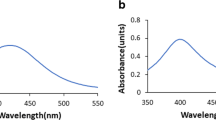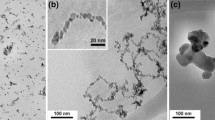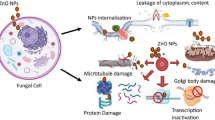Abstract
Nanocomplexes based on a modern Taunit nanosorbent with polyene antibiotics (amphotericin B, nystatin A1, and natamycin) widely used in medical practice were obtained for the first time; their antifungal activity was studied. It was demonstrated that the Taunit–nystatin A1 complex is active as compared to Aspergillus niger, while the Taunit–natamycin complex is active as compared to Aspergillus niger and Candida albicans. The Taunit–amphotericin B nanocomplex is not active relative to the studied test organisms (A. niger and C. albicans). Possible mechanisms of the action of the obtained complexes are discussed.
Similar content being viewed by others
Abbreviations
- DMSO:
-
dimethyl sulfoxide
- CFU:
-
colony-forming unit
- MCNT:
-
multilayer carbon nanotubes
- MRSA:
-
meticillinresistant Staphylococcus aureus
References
Richards, M.I., Edwards, J.R., Culver, D.H., and Gaynes, R.P., Nosocomial infections in medical intensive care units in the United States. National nosocomial infections surveillance system, Crit. Care Med., 1999, vol. 27, pp. 887–892.
McNeil, M.M., Hash, S.L., Hajjeh, R.A., Phelan, M.A., Conn, L.A., Pliraytis, B.D., and Wamock, D.W., Trends in mortality due to invasive mycotic diseases in the united states, 1980-1997, Clin. Infect. Diseases, 2001, vol. 33, no. 5, pp. 641–647.
Wisplinghoff, H., Bischoff, T., Tallent, S.M., Seifert, H., Wenzel, R.P., and Edmond, M.B., Nosocomial bloodstream infections in us hospitals: analysis of 24179 cases from a prospective nationwide surveillance study, Clin. Infect. Diseases, 2004, vol. 39, no. 3, pp. 309–317.
Hospenthal, D.R., Mandell, G.L., Bennett, J.E., and Dolin, R., “Uncommon fungi”, in Mandell, Douglas, and Bennett’s Principles and Practice of Infectious Diseases, 6th ed., Philadelphia, USA, Churchill: Livingstone, 2005, vol. 2, pp. 3068–3079.
van Thiel, D.H., George, M., and Moore, C.M., Fungal infections: their diagnosis and treatment in transplant recipients, Int. J. Hepatol., 2012, vol. 12, pp. 1–19.
Ae Jung Huh and Young Jik Kwon, Nanoantibiotics: a new paradigm for treating infectious diseases using nanomaterials in the antibiotics resistantera, J. Controlled Release, 2011, vol. 156, pp. 128–145.
Mishchenko, S.V. and Tkachev, A.G., Uglerodnye nanomaterialy. Proizvodstvo, svoistva, primenenie (Carbon Nanomaterials: Production, Properties, and Applications), Moscow: Mashinostroenie, 2008.
Timofeeva, A.V., Galatenko, O.A., Il’ina, M.V., Terekhova, L.P., and Katrukha, G.S., Obtaining and research of antimicrobial activity of “antibiotic-nanotube"-type complexes ("Taunit” antibiotic), in Proc. 9th Int. Sci. Pract. Conf. “Future Investigations, vol. 22: Medicine, Sofia: Byal GRAD-BG LTD, 2013. p. 112.
Milton, B., Sloane. a new antifungal antibiotic, mycostatin (nystatin) for the treatment of moniliasis: a preliminary report, J. Investigat. Dermatol., 1955, vol. 24, pp. 569–571.
Stark, J. and Tan, H.S., Natamycin, New York: Plenum Publishers, 2003.
Brajtburg, J., Powderly, W.G., Kobayashi, G.S., and Medoff, G., Amphotericin B: current understanding of mechanisms of action, J. Antimicrob. Agents. Chemother., 1990, vol. 34, no. 2, pp. 183–188.
Eremenko, A.S., and Vlasov, A.I., Study of carbon fibers and carbon nanotubes, in Dvenadtsataya nauchnaya konf. “Shag v budushchee” (12th Sci. Conf. “A Step into the Future”), Moscow, 2009.
Haese, A. and Keller, U., Genetics of actinomycin c production in Streptomyces chrysomallus, J. Bacteriol., 1988, vol. 170, no. 3, pp. 1360–1368.
Odds, F.S., Sordarin antifungal agents, Expert Opin. Ther., 2001, vol. 11, pp. 283–294.
Baginski, M. Czub, J., Amphotericin B and its new derivatives-mode of action, Curr. Drug Metab., 2009, vol. 10, pp. 459–469.
Van de Ven, H., Paulussen, C., Feijens, P.B., Mate heeussen, A., Rombaut, P., Kayaert, P., Van den Mooter, G., Cos, P., Maes, L., and Ludwig, A., PLGA nanoparticles and nanosuspensions with amphotericin B: potent in vitro and alternatives to fungisone and ambisome, J. Controlled Release, 2012, vol. 161, pp. 795–803.
Prajapati, V.K., Awasthi, K., Gautam, S., Yadav, T.P., Rai, M., Srivastava, O.N., and Sundar, S., Targeted killing of Leishmania donovani in vivo with amphotericin B attached to functionalized carbon nanotubes, J. Antimicrob. Chemother., 2011, vol. 66, pp. 874–879.
Hamilton-Miller, J.M.T., Chemistry and biology of the polyene macrolide antibiotics, Bacteriol. Rev., 1973, vol. 37, no. 2, pp. 166–196.
Eletskii, A.V., Carbon nanotubes, Usp. Fiz. Nauk, 1997, vol. 167, no. 9, pp. 945–972.
Heve, M., Duboury, J.C., Borowski, E., Cybulska, B., and Gary-Bobo, C.M., The role of the carboxyl and amino groups of polyene macrolides in their interaction with sterols and their selective toxicity. a 31p-nmr study, Biochim. Biophys. Acta, 1989, vol. 98, pp. 261–272.
Tanford, C., The Hydrophobic Effect: Formation Of Micelles And Biological Membranes, New York: John Wiley and Sons Inc., 1980.
Eletskii, A.V., Sorption properties of carbon nanostructures, Usp. Fiz. Nauk, 2004, vol. 174, no. 11, pp. 1191–1231.
Author information
Authors and Affiliations
Corresponding author
Additional information
Original Russian Text © A.V. Timofeeva, M.V. Ilyina, E.A. Stepashkina, L.A. Baratova, G.S. Katrukha, 2014, published in Biotekhnologiya, 2014, No. 3, pp. 18–23.
Rights and permissions
About this article
Cite this article
Timofeeva, A.V., Ilyina, M.V., Stepashkina, E.A. et al. Production of taunit–antibiotic nanocomplexes and study of their antifungal activity relative to Aspergillus niger and Candida albicans . Appl Biochem Microbiol 51, 887–892 (2015). https://doi.org/10.1134/S0003683815090070
Received:
Published:
Issue Date:
DOI: https://doi.org/10.1134/S0003683815090070




